Little puffballs mushrooms occur across the country, as any little kid who’s ever stomped on one can tell you. Maybe you’ve stomped on a few yourself. It’s great fun! The little puffy mushroom gems, though, are also edible, as long as you catch them when they’re young.


Jump to:
- About Little Puffball Mushrooms
- Little Puffballs vs. Giant Puffballs: What’s the Difference?
- Are Little Puffball Mushrooms Edible?
- A Brief Orientation to North American Little Puffball Mushrooms
- The Little Lycoperdon Puffballs – An Introduction
- The Little Bovista Puffballs – An Introduction
- More Little Puffballs – There’s a Lot of Them!
- Foraging Little Puffball Mushrooms
- Harvesting and Cooking Little Puffballs
- Little Puffball Lookalikes
- Little Puffball Mushrooms Common Questions
About Little Puffball Mushrooms
Puffball mushrooms are usually white, but there are brown species as well. They are distinguishable by their rounded shape, puffy interior, and unusual spore disbursement. Puffballs don’t have gills, stems, or even caps like the common mushroom. Most of them look like little white light bulbs or an inverted pear shape.

When it’s young, the puffball mushroom is spongy or puffy – if you lightly poke it, the flesh springs back like a nice cushion. As it matures, the interior flesh yellows, turns brown, and finally becomes powdery. This is the puffball that’s fun to stomp – it releases a poof of dark olive green or black spores in a great cloud.
Puffball mushrooms occur spring through fall and even in winter in warmer climates. They’re very hardy, adaptable, widespread, and pretty easy to identify as a whole. While it can be hard to differentiate between the different species, it’s usually easy to determine it is a puffball of some sort. They look like golf balls or white marbles lying in a meadow or scattered across the forest floor.
All puffball mushrooms are saprotrophic, meaning they feed on decaying organic material. In most cases, the decaying material is wood, and you’ll find little puffballs on dead or dying trees and stumps.
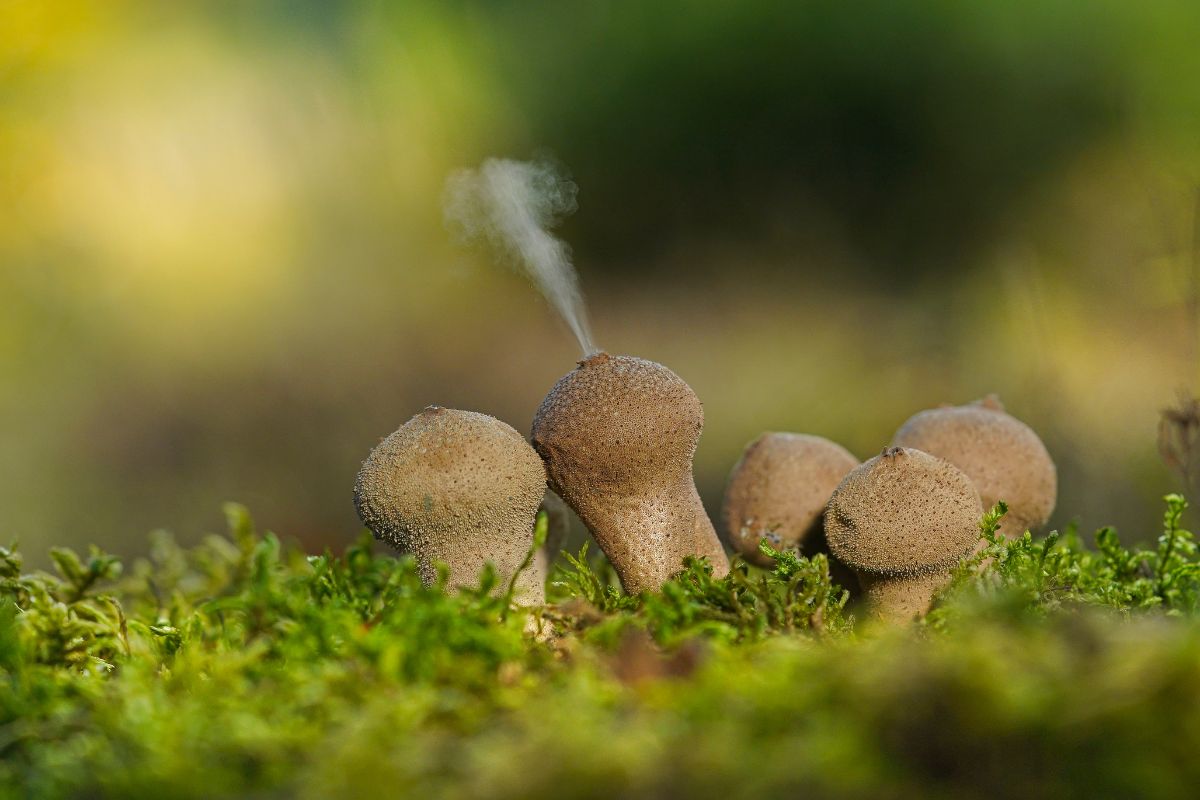
Little Puffballs vs. Giant Puffballs: What’s the Difference?
The only difference is size. And size is subjective. In fact, I’ve split all the puffballs into two groups based on my own ID preferences (what I find easy). This guide to “little” puffballs includes those that are smaller than a softball in size. I’ve regulated any puffball species softball-sized or larger to “Giant,” and you can find a guide to all the Giant Puffballs here.

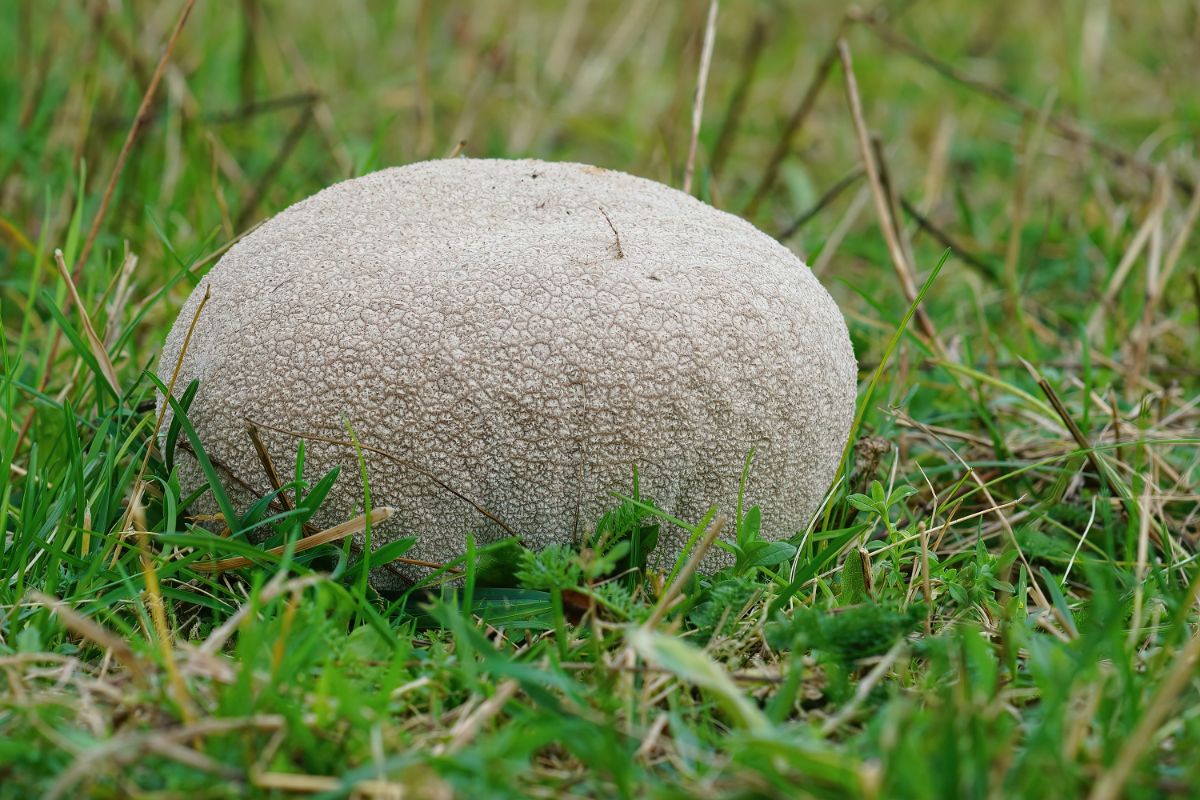
Are Little Puffball Mushrooms Edible?
Yes, the majority of little puffballs are edible. Puffball mushrooms, the giant ones and the little ones, are pretty bland in flavor. They’re lovingly referred to as the “tofu of mushrooms” by foragers. The white flesh is thick and spongy and cooks down a lot with heat.
Like tofu, the puffball easily absorbs flavors, so it is an excellent mushroom to include in other more flavorful dishes, like stews or stirfries. They’re also excellent lightly battered, and fried. One downside to foraging the little ones is it you’ll have to harvest quite a few to make a meal.


Puffballs aren’t top on the mushroom taste spectrum, but they’re a fun and easy find and can be used in various ways. Many people dry and powder the little puffballs to be added to soups and stews as a thickener and for extra robustness.
A Brief Orientation to North American Little Puffball Mushrooms
Once you start looking through the species outlined in this guide, you might start to notice something. First, there are a LOT of little white puffball mushrooms. Second, it’s difficult to tell them all apart. Both these are true, and there isn’t much a forager can do except learn as best they can the differences and take some patience with them as they sort through all the types.


What can we say; the fungi kingdom is diverse and unique, and nature does what it wants. If Mother Nature says there are going to be 40 similar-looking little white puffball-esque mushrooms, then that’s what there’s going to be. This guide is only a beginning introduction to the species. Believe it or not, there are a lot more.
The Little Lycoperdon Puffballs – An Introduction
There are over 50 species of Lycoperdon puffball mushrooms around the world. Most of them are edible, as long as the inside is completely white. This guide doesn’t cover all the Lycoperdons in North America, just some of the most common. As you’ll see, they are all similar in size and features.
Fun Fact: Lycoperdon is Greek and translates to wolf-farts!
Common Puffball (Lycoperdon perlatum)
- Region: Worldwide; the most common puffball species in North America
- Season: Spring through fall, also winter in warmer climates
- Habitat: Meadows, roadsides, landscaped areas, forests on dead trees and stumps
- Size: 5/8-2 3/8 inches wide, 1 1/8-2 ¾ inches tall
- Shape: Pear-shaped with a flat top or round
- Color: White
- Outer Surface: Grain-sized white or brown warts and little white or grayish spines that are easily rubbed off. Spines leave a mark on outer skin when shed.
- Inner flesh color: White, then turns yellow and brown.
- Notes: Lycoperdon perlatum is so common and widespread that it has appeared on postage stamps in Romania, Sierra Leone, Paraguay, Sweden, and Guinea. It is also known as the warted puffball, gem-studded puffball, and devil’s snuffbox.

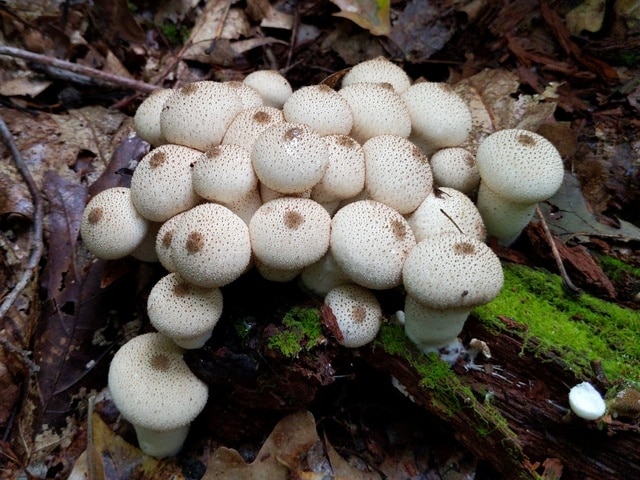

Pedicel Puffball (Lycoperdon caudatum)
- Region: North America, widespread
- Season: Spring through fall, more common in fall
- Habitat: Under conifers and hardwoods, on decaying wood
- Size: 1-2 inches wide, 1.5-2.5 inches tall
- Shape: Pear-shaped
- Color: Whitish to tan or brown
- Outer Surface: Covered in tiny granular tan-ish spines that do not leave a mark when rubbed off.
- Inner flesh color: White, then yellow and brown
- Notes: Very similar to L. perlatum; some sources even consider them the same, but microscopic analysis says they are different. The main differing feature to the naked eye is the results on the outer surface when you brush off the spines.

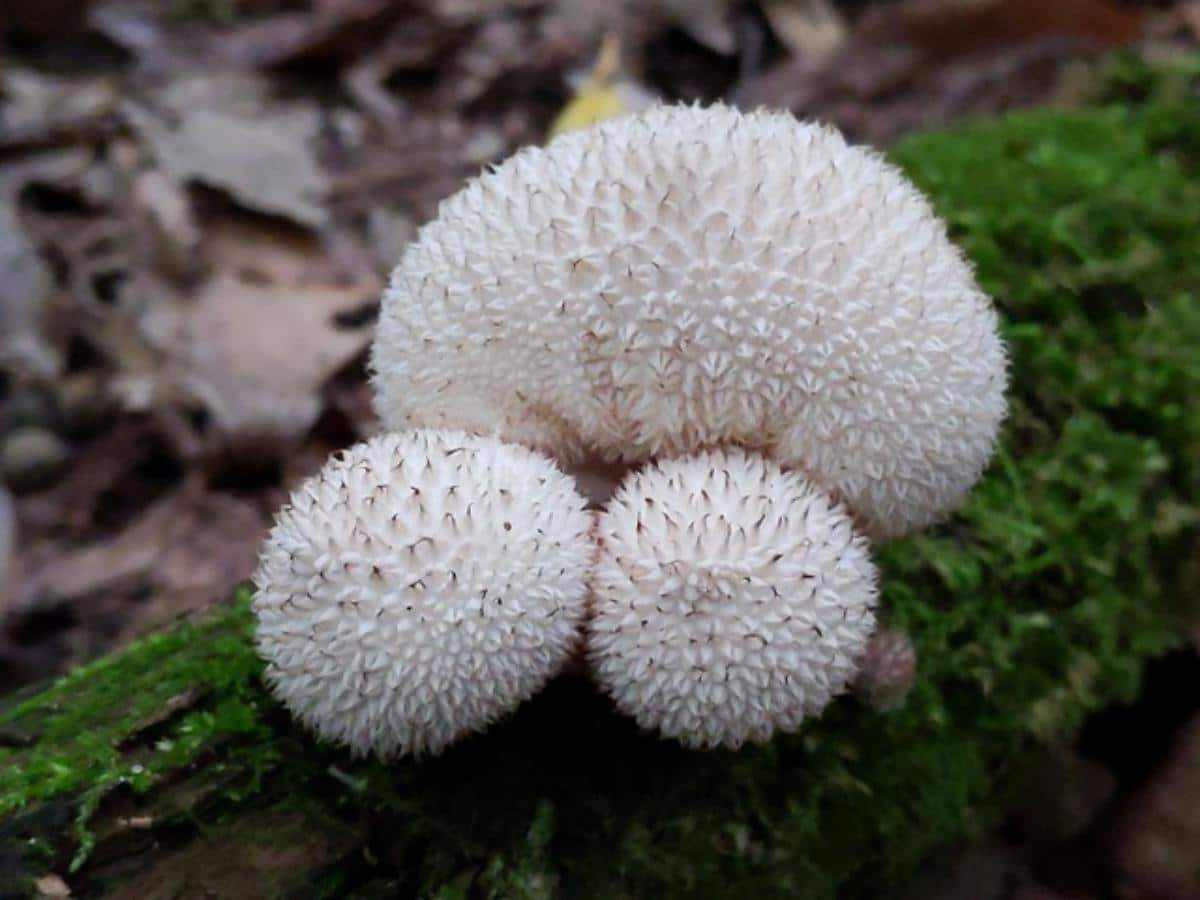
Curtis’s Puffball (Lycoperdon curtisii)
- Region: Across North America
- Season: Late summer through fall
- Habitat: Meadows, disturbed ground, woodchips
- Size: .5-1.25 inches wide
- Shape: Round, but often contorted because of clustered growth
- Color: White
- Outer Surface: Dense distinctive soft white spines that rub off easily.
- Inner flesh color: White, then turns yellow and purple-brown
- Notes: Commonly grows in dense clusters of 3-10 puffballs, which causes them all to grow distorted as they push against each other’s spaces. In maturity, the spines may entirely fall off, turning this spiny puffball into a smooth one. Clustered growth habit is a key identification feature.


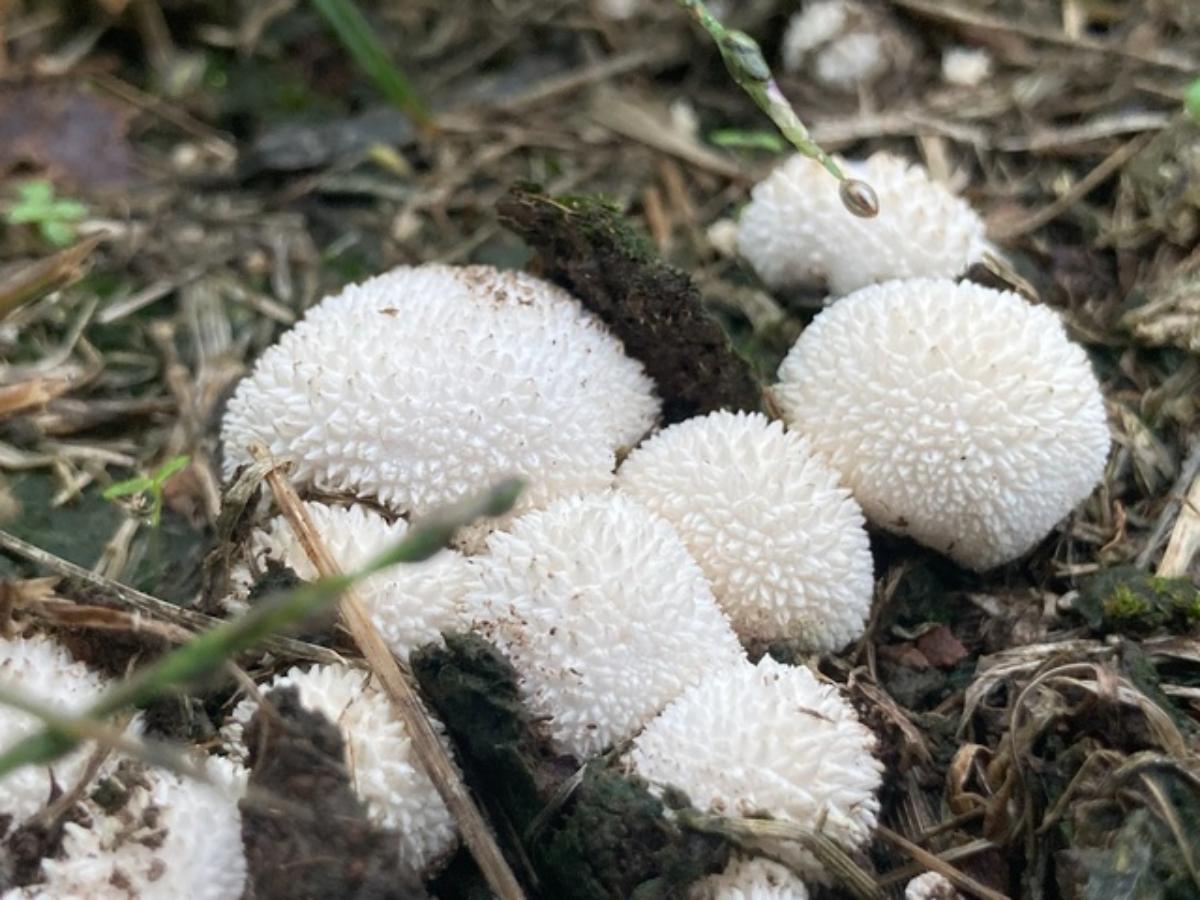
Spiny Puffball (Lycoperdon echinatum or Lycoperdon americanum potentially)
- Region: Across North America, more common east of the Rocky Mountains
- Season: Spring through autumn
- Habitat: Grassy areas, disturbed land, pastures, may prefer beech woods
- Size: .5-1.5 inches wide, .5-1.5 inches tall
- Shape: Pear-shaped or mostly rounded
- Color: White or light brown
- Outer Surface: Covered in dense spines; spines often joined at the tips. The spines flake off with age to reveal a net-like outer surface.
- Inner flesh color:
- Notes: Brown spiny puffballs look like oak burrs. The lower half of the spiny puffball is often a different color than the top, usually off-white or grayish-purple. “Echinatum” is derived from the Greek word echinos which means hedgehog or sea-urchin.



Peeling Puffball (Lycoperdon marginatum) [mixed edibility reports]
- Region: North America, widespread
- Season: Spring through fall, possibly into winter
- Habitat: Sandy soil, oak-pine woods
- Size: .5-2 inches wide
- Shape: Round, but become flattened or light bulb shaped in maturity.
- Color: White
- Outer Surface: Covered in short white spines. The spiny outer layer peels off in chunks to reveal a smooth, brown surface underneath.
- Inner flesh color: White, then greenish-brown, then gray-brown
- Notes: Edibility unknown – mixed reports say it may cause auditory hallucinations?

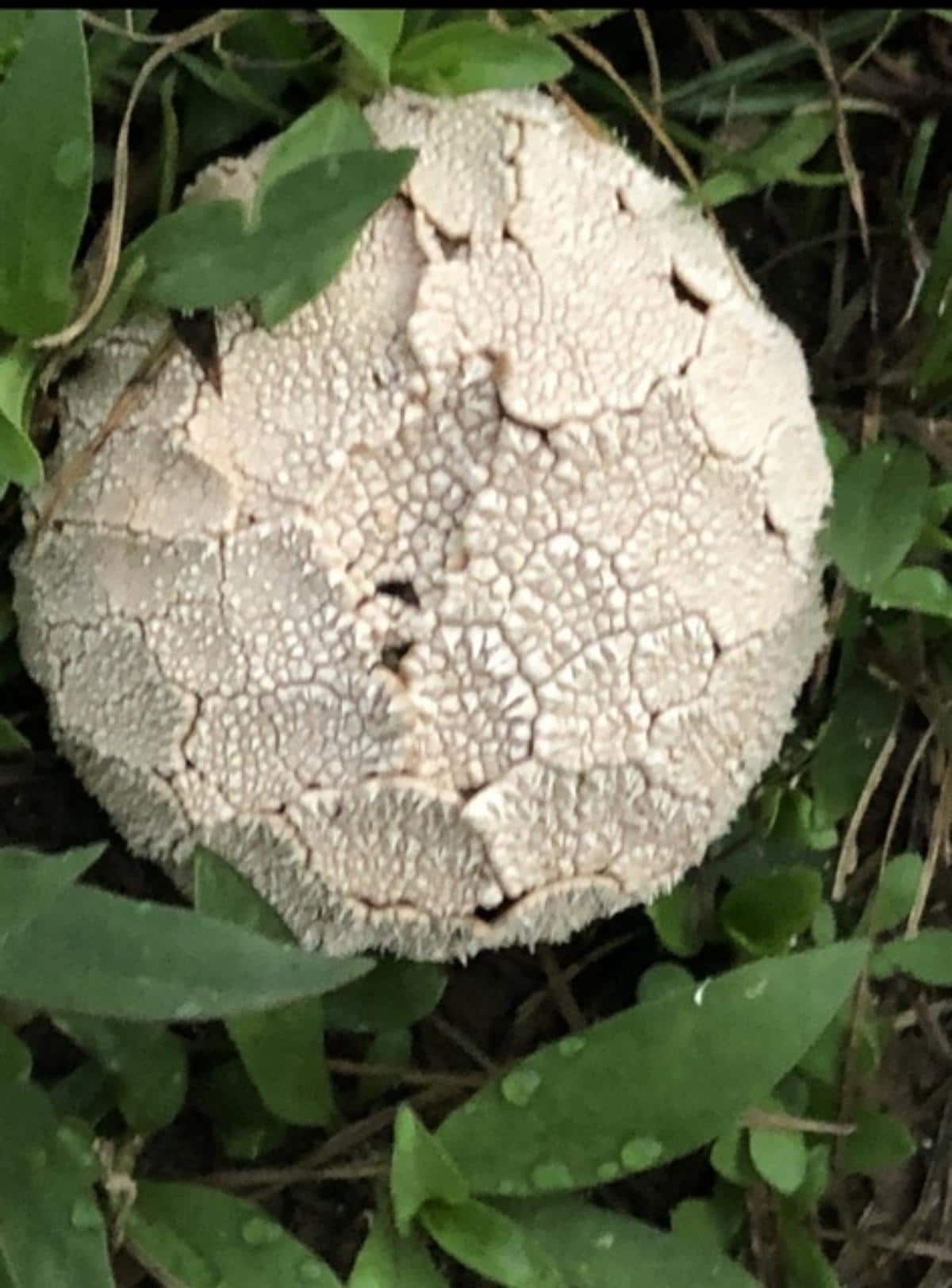

Smooth Puffball (Lycoperdon molle)
- Region: North America, widespread
- Season: Late fall to mid-winter
- Habitat: Soil, grassy areas, with conifers or hardwoods, disturbed land
- Size: 1-2 inches wide, 1-2.25 inches tall
- Shape: Pear-shaped
- Color: Cream to pale tan, turns brown in maturity
- Outer Surface: Covered in very short spines or granules (sand-like)
- Inner flesh color: White, then yellowish-green and dark-brown
- Notes: It looks very similar to L. umbrinum.



Umber-Brown Puffball (Lycoperdon umbrinum)
- Region: North America, widespread
- Season: Summer through fall, winter in warmer climates
- Habitat: Wooded or sandy areas with conifers
- Size: .5-1.5 inches wide, .75-2 inches tall
- Shape: Pear-shaped
- Color: Pale brown, to reddish-brown, then black-brown
- Outer Surface: Tiny spines or granule
- Inner flesh color: White, then brown to dark brown
- Notes: Uncommon species



Long-spined Puffball (Lycoperdon pulcherrimum)
- Region: Eastern North America, Midwest, and Great Plains, less frequently in the southwest
- Season: Summer through fall
- Habitat: Around trees in wooded or urban settings
- Size: .75-2.25 inches wide, .75-2.25 inches tall
- Shape: Round or pear-shaped
- Color: White
- Outer Surface: Covered densely with long, soft, white spines. Spines are often joined at the tips.
- Inner flesh color: White, then yellow to olive-brown
- Notes: Similar to L. curtisii, except that species is marble-sized while the Long-spined puffball is golf ball sized. Also similar to L.echinatum, but that species’ outer surface becomes pock-marked when the spines fall off. The long-spined puffball remains smooth after the spines fall off.



Small-Warted Mountain Puffball (Lycoperdon subcretaceum (formally Calvatia)
- Region: western North America
- Season: Summer through fall
- Habitat: conifer forests
- Size: 1-2 inches wide, 1-1.5 inches tall
- Shape: Round
- Color: White to tan to light brown
- Outer Surface: Covered in shallow yet broad pyramid-shaped warts and scales
- Inner flesh color: White, then brown
- Notes: Often mistaken for a Scleroderma because of the outer appearance, which isn’t classically puffball-like. Cutting it open quickly proves it is a puffball. Still commonly found listed as Calvatia subcretacea in guide books.



Stump Puffball (Apioperdon pyriforme, formerly Lycoperdon pyriforme)
- Region: North America, widespread
- Season: Fall into winter, sometimes spring and summer but not as often
- Habitat: Decaying logs, dead wood, appearing in dense clusters
- Size: .75-1.25 inches wide, .75-1.75 inches tall
- Shape: Rounded when young, pear-shaped with age
- Color: Light tan to brown
- Outer Surface: When young, the outer surface is covered in tiny white spines. These fall off in maturity to create a smooth surface.
- Inner flesh color: White, then yellow to olive to brown
- Notes: This puffball was moved to its new genus in 2017 and is the only one in the genus. Many field guides still use Lycoperdon pyriforme. Also known as the pear-shaped puffball. This is one of the few puffballs that grows on wood instead of grassy meadows or disturbed ground. Often a log will be covered in hundreds of these puffballs.
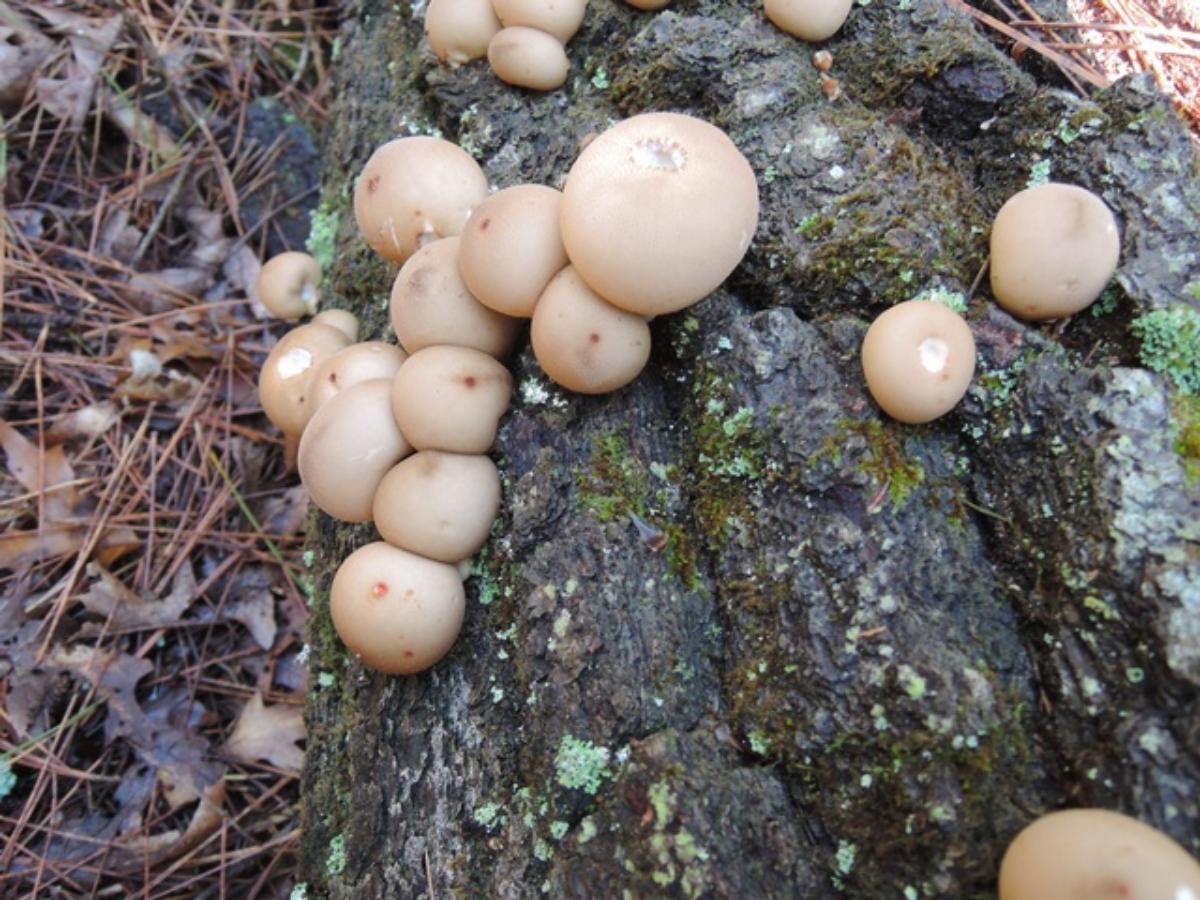


The Little Bovista Puffballs – An Introduction
The puffball mushrooms in this genus are known as the “true” puffballs. They were initially classified with the Lycoperdons along with many others, but then molecular studies split all the puffballs into different groups. They are called the “true” puffballs because they are stemless and only attach to the ground through very thin mycelial cords.
Bovista longispora, also known as Lycoperdon oblongisporum
- Region: North America, widespread east of the Rockies
- Season: Summer
- Habitat: Grassy areas, disturbed land
- Size: Less than an inch in diameter
- Shape: Round
- Color: White
- Outer Surface: When young, covered in tiny sand-like granules. Smooth and tan when mature.
- Inner flesh color: White, then yellow olive brown
- Notes:



Tumbling Puffball (Bovista pila)
- Region: Widespread across North America
- Season: Summer through early winter
- Habitat: Pastures, grassy areas, roadsides
- Size: maximum 3” diameter
- Shape: Egg-shaped to spherical
- Color: White or very light pink at first, but flakes to reveal shiny bronze skin
- Outer Surface: May see it all white, in between with white skin flaking off, or entirely shiny bronze.
- Inner flesh color: White, then green to brown
- Notes: Mycelial cord that attaches the puffball to the ground detaches easily, sending the puffball tumbling around in the wind.
- This puffball is used medicinally by native Americans to prevent bleeding from minor cuts and wounds. Farmers in Canada use it for the same purpose, treating small cuts on livestock from hoof and horn trimmings.



Paltry Puffball (Bovista plumbea)
- Region: California, possibly other areas
- Season: Spring through fall
- Habitat: Grassy spots, disturbed areas
- Size: Less than 1.5 inches in diameter
- Shape: Round or slightly egg-shaped
- Color: White or light gray
- Outer Surface: Often looks dried out, like cracked mud or elephant skin
- Inner flesh color: White, then yellow then brown
- Notes: Outer skin peels away when mature



More Little Puffballs – There’s a Lot of Them!
Arachnion album (edibility unknown)
- Region: East of the Rocky Mountains, less common on the west coast
- Season: Summer through fall
- Habitat: Lawns, pastures, disturbed areas
- Size: Less than an inch wide and less than an inch tall.
- Shape: Round
- Color: White or light tan
- Outer Surface:
- Inner flesh color: White but turns gray then blackish brown
- Notes: The interior is comprised of tiny sand-like granules – each granule is a minuscule packet of spores.



Gastropila fumosa, formerly Calvatia (edibility unknown)
- Region: Rocky mountains and westward
- Season: Spring and summer
- Habitat: Soil in spruce and fir forests
- Size: 1.25-3.25 in diameter
- Shape: Round
- Color: White, but turns grayish or tan
- Outer Surface:
- Inner flesh color: White, then yellow to brown
- Notes: This one’s a stinker, literally. It has a pungent odor, especially when young.



Foraging Little Puffball Mushrooms
Season
The season for little puffballs varies depending on the region. Mostly they are summer or fall mushrooms, but on the west coast, they are often found in the winter as well.
Habitat
The majority of little puffballs grow in grass, meadows, pastures, or other similar places where the ground is disturbed, and there is grass growing. Landscaped areas are an excellent place to look, as well. Because little puffballs are saprotrophic, they seek out dead or decaying material, which can be mulch, wood chips, buried wood, or decaying leaves.
One little puffball, the stump puffball, is the only one that grows just on dead wood. Other species can be found on decaying wood, but they’ll also grow in grass or mulch. The stump puffball doesn’t grow in meadows or grassy areas.

Identification
Because there are so many species, a singular identification isn’t possible. However, there are features that all of these basically share, with some minor differences.
- Rounded top – Whether completely round, spherical, or pear-shaped, the overall shape is generally rounded.
- Small, golf-ball sized, or much smaller.
- No gills, no cap. Stem is not separate.
- Grows in clusters or dense scatterings. It is rare to find just one little puffball.
- Interior is pure white in youth and changes to yellow and then some form of powdery brown in maturity.
- Before the insides get powdery, the white flesh is dense and spongy, like a marshmallow.

Harvesting and Cooking Little Puffballs
Because they’re so small, you’ll need to collect quite a few to make any type of puffball-centered meal. Most times, little puffballs are used as a side dish or added to a larger dish because there just aren’t a lot of them.
Preparing them for cooking is relatively easy, though time-consuming depending on your preference for eating.
- Give the puffballs a quick rinse under running water to remove any dirt or debris.
- Cut the ends off where it was connected to the ground or wood.
- Some people peel puffballs because the outer skin is usually tougher. It really depends on the type of puffball – thicker-skinned ones are best peeled, but mostly a puffball doesn’t need peeling. Plus, it’s a lot of work to do so.
- Slice the puffballs in half (always checking to make sure they’re not yellow and are real puffballs)
- Saute in a hot unoiled pan for 1-3 minutes to remove excess moisture.
- Add seasoning or sauce and cook.
Little Puffball Mushroom Recipes
Little Puffball Lookalikes
Amanita Babies
All Amanita species start out from a round white egg, which looks quite like a little puffball. The amanitas only stay in this form for a short while before their cap emerges and a stem appears. However, for that very short time frame, misidentification is a common issue.
This misidentification is especially troublesome because Amanitas are among some of the most poisonous mushrooms around. This is not a mushroom you want to get confused with a puffball. The first thing to note is whether the round white mushroom is in the ground or on top of the soil. Amanitas usually are partially to entirely buried. Puffballs are never buried. However, sometimes an Amanita egg will be completely above ground, so you can’t use this as the only discerning factor.
The easiest, quickest, and surest way to tell them apart is to cut the mushroom open. An amanita egg will have the “unhatched” mushroom inside, with gills and a cap. Sometimes you have to look VERY closely, but you’ll see them if they’re there. Get out the bifocals if you need to.
The interior flesh of an amanita egg is also different than a little puffball. In addition to the gill outline, the amanita flesh is compact and rather solid. Little puffball flesh, on the other hand, is spongy or springy.

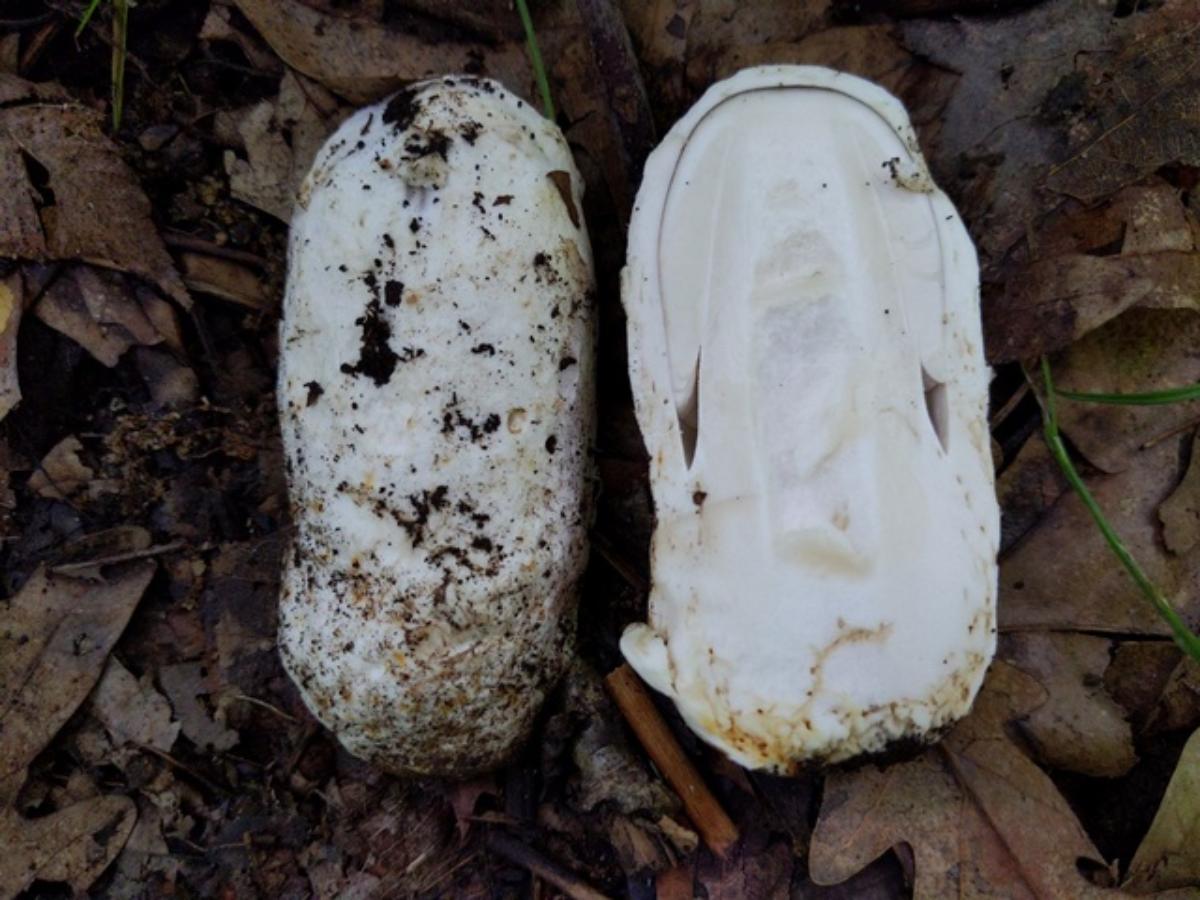

Amanita egg cross section by Daniel B. Wheeler on Mushroom Observer
Scleroderma
Scleroderma fungi, also known as earth balls, are small and round, just like little puffballs. They are rarely white, but they can be confused with some of the little puffballs that turn light tan or brown.
The most significant difference, and a straightforward way to tell them apart, is, again, cutting them open (in case you haven’t caught on, it’s always a good idea to cut a puffball-looking fungus in half!). Earth balls are all black inside. Their exterior is also quite thick and tough.

Little Puffball Mushrooms Common Questions
Is there any danger in eating puffballs?
Puffball mushrooms are bioaccumulators. This means they absorb toxins from the material or environment they are growing in. Puffballs growing near highways absorb fumes and other chemicals you probably don’t want to ingest. Be cautious where you forage puffballs, and you’ll be fine.
Of course, always, always, check the inner flesh to make sure it is pure white. Even the slightest bit of yellowing will cause stomach upset.
Do puffball mushrooms have to be cooked?
Yes. We recommend cooking all wild mushrooms. They likely won’t kill you if you eat them raw but will cause unpleasant gastrointestinal distress.
What can you do with a puffball?
Puffballs can be sautéed, added to pasta sauce, used in stirfries, or dehydrated to be used as a soup thickener.
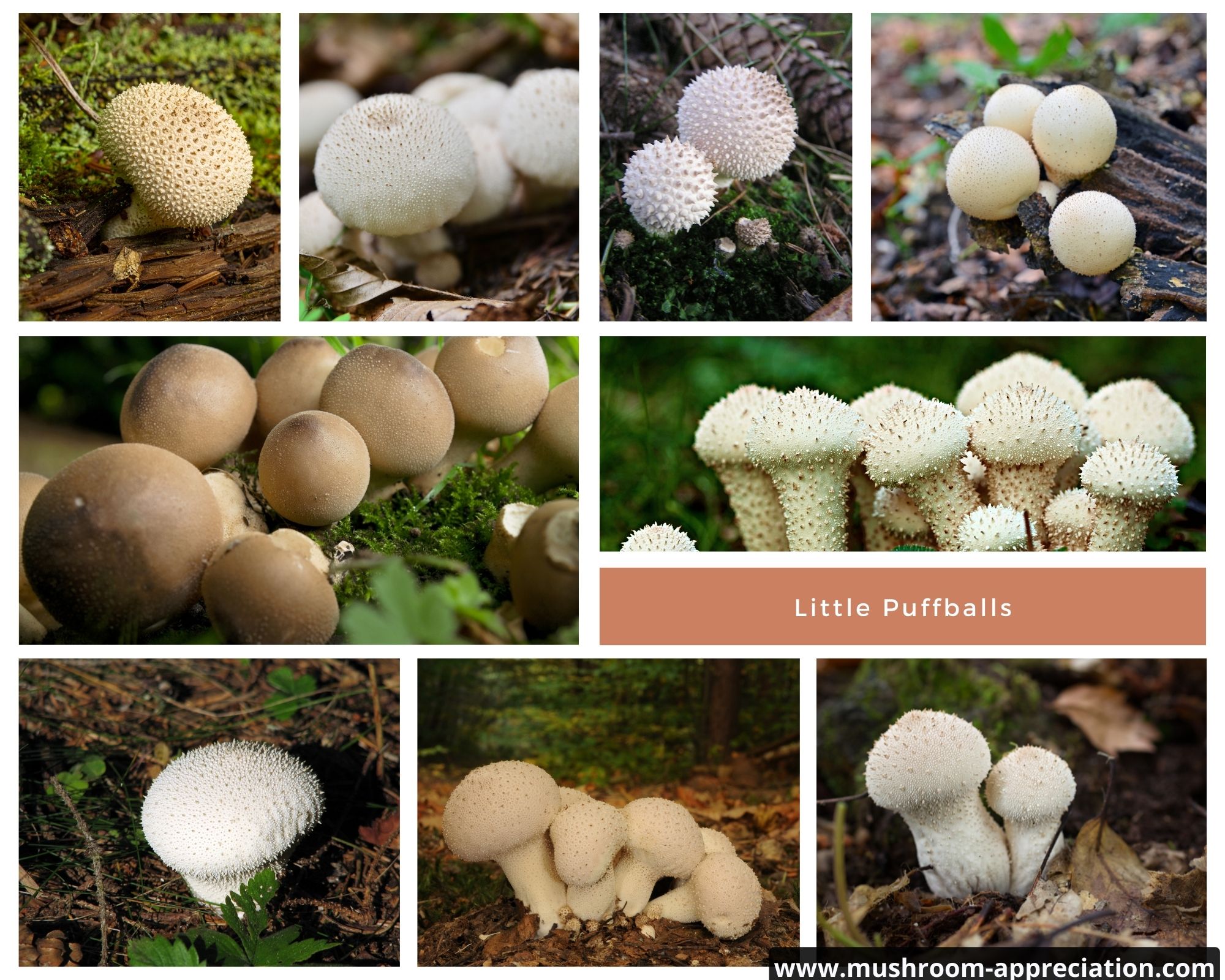





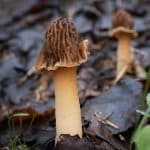



Charles Behnke says
I have a, what looks like a puff ball on a stem straight up from the ground, around 3 inches tall currently, and the ball sitting on top is 1 inch round with light brown “lines similar to a geodesic dome, or a wadded up piece of paper. Very interesting and through website, Thanks
Jenny says
Thank you for visiting! Did you take a look at the giant puffball article — it sounds a lot like the sculpted puffball and they do get 3″ diameter or bigger https://www.mushroom-appreciation.com/puffball-mushrooms.html